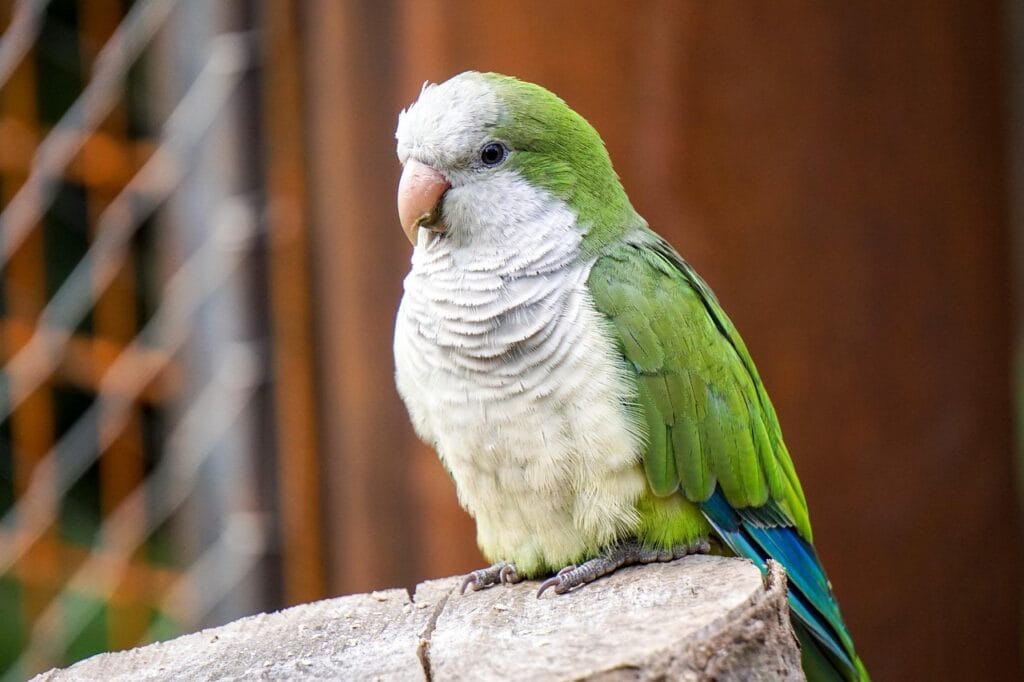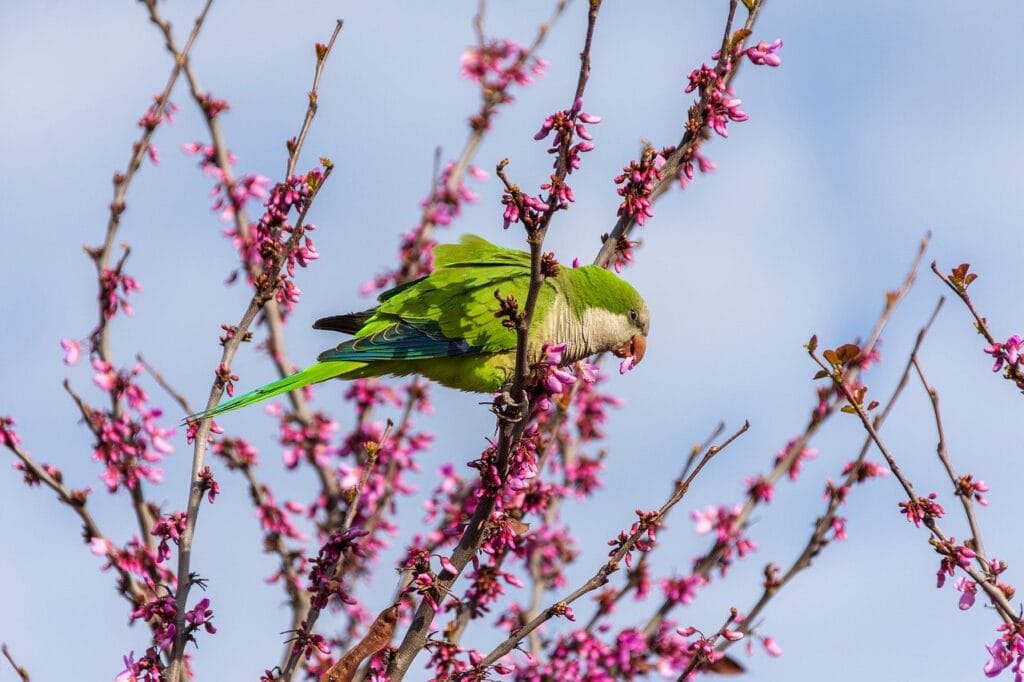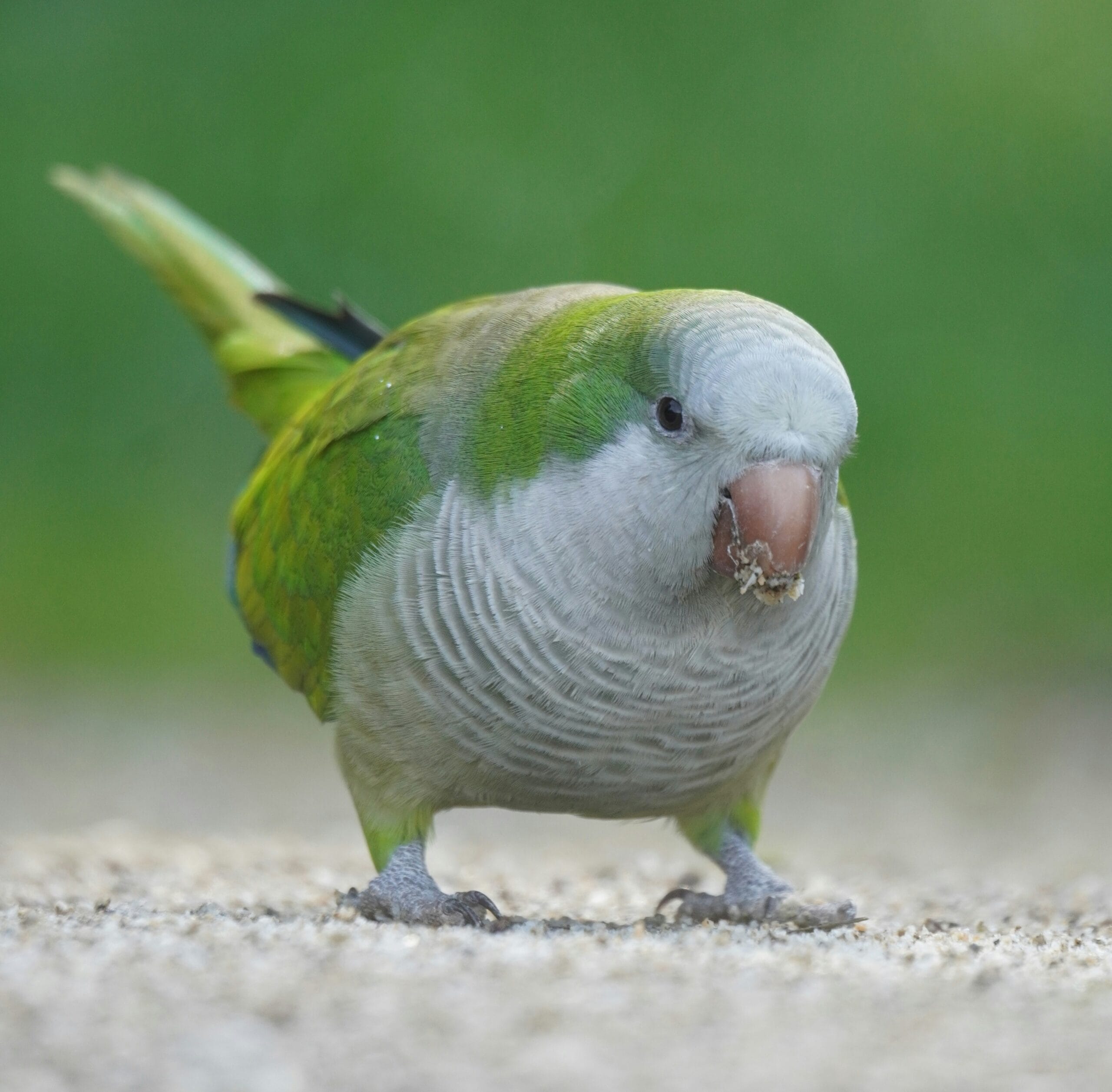Monk Parakeet Behavior – 8 Surprising Traits That Will Amaze You
The Monk Parakeet (Myiopsitta monachus) stands out as one of nature’s most remarkable avian species, captivating researchers and bird enthusiasts worldwide with its extraordinary behavioral patterns. These vibrant green parrots, also known as Quaker parrots, exhibit complex social structures and adaptive abilities that challenge our understanding of avian intelligence. Understanding Monk Parakeet behavior reveals fascinating insights into their survival strategies, communication methods, and remarkable adaptability to diverse environments.
Table of Contents
Understanding the Monk Parakeet: An Introduction to Their World
The Monk Parakeet originates from South America, particularly Argentina, Paraguay, Uruguay, and southern Brazil. These medium-sized parrots measure approximately 11-12 inches in length, with their distinctive bright green plumage, gray faces, and pale yellow-green underparts making them easily recognizable. What truly sets the Parakeet apart from other parrot species is their exceptional behavioral complexity and social intelligence.
Unlike many parrot species that nest in tree cavities, the Parakeet demonstrates remarkable architectural prowess by constructing elaborate communal nests. These structures serve as the foundation for their intricate social systems and represent just one of many surprising behavioral traits that make this species extraordinary.
The Architecture Masters: Communal Nest Building
Engineering Marvels in the Avian World
The most astounding Monk Parakeet behavior involves their sophisticated nest-building capabilities. These birds construct massive communal structures using twigs, branches, and various plant materials, creating what can only be described as avian apartment complexes. A single Parakeet colony nest can house dozens of breeding pairs, with some structures reaching weights of over 200 pounds and spanning several feet in diameter.
The construction process reveals remarkable cooperation and planning abilities. It’s individuals work together systematically, with different birds specializing in gathering materials, weaving structural elements, and maintaining the overall integrity of the nest. The interior features multiple chambers, each serving specific purposes from breeding to roosting, demonstrating sophisticated spatial organization that rivals human architectural planning.
Structural Complexity and Functionality
Each Monk Parakeet nest chamber is meticulously crafted with entrance tunnels that provide protection from predators and weather elements. The birds demonstrate remarkable engineering knowledge by creating drainage systems within their nests, preventing water accumulation during heavy rains. This behavior showcases their ability to anticipate environmental challenges and implement preventive solutions.

Social Hierarchies: Complex Community Dynamics
Establishing Pecking Orders
Monk Parakeet colonies operate under sophisticated social hierarchies that govern access to prime nesting locations, food resources, and mating opportunities. Dominant pairs typically occupy the most protected central chambers of communal nests, while subordinate individuals are relegated to peripheral locations with increased exposure to predators and environmental stresses.
The establishment of these hierarchies involves complex behavioral displays including vocalizations, posturing, and controlled aggressive interactions. Monk Parakeet individuals demonstrate remarkable memory capabilities by recognizing dozens of colony members and maintaining awareness of their respective social standings over extended periods.
Cooperative Breeding and Communal Care
One of the most surprising Monk Parakeet behaviors involves their cooperative breeding systems. Non-breeding individuals often assist breeding pairs with nest maintenance, territory defense, and even chick feeding. This altruistic behavior, relatively uncommon among parrot species, suggests advanced social cognition and community-oriented thinking.
Young Monk Parakeet individuals remain with their natal colonies for extended periods, contributing to communal activities while learning essential survival skills. This extended family structure creates multi-generational knowledge transfer systems that enhance colony survival rates and behavioral sophistication.
Communication Specialists: Vocal Learning and Mimicry
Advanced Vocal Repertoires
The Monk Parakeet possesses extraordinary vocal learning abilities that extend far beyond simple species-specific calls. These birds develop extensive vocabularies of contact calls, alarm signals, and social communication sounds that vary between different colonies and geographic regions. Research indicates that Monk Parakeet populations develop distinct “dialects” based on their geographic locations and social group compositions.
Individual Monk Parakeet birds can produce over 40 different vocalizations, each serving specific communicative functions within their social structure. These calls convey information about food availability, predator presence, social status, and individual identity, creating a sophisticated communication network that facilitates complex colony coordination.
Contextual Communication and Mimicry
Perhaps most remarkably, Monk Parakeet individuals demonstrate contextual learning abilities by incorporating human-made sounds and other environmental noises into their vocal repertoires. Urban Monk Parakeet populations have been observed mimicking car alarms, construction sounds, and even human speech patterns with remarkable accuracy.
This mimicry behavior extends beyond simple sound reproduction to include appropriate contextual usage. Monk Parakeet birds have been documented using learned human sounds to communicate with other colony members, suggesting abstract understanding of sound-meaning relationships that challenges traditional concepts of animal communication.
Problem-Solving Intelligence: Cognitive Capabilities
Tool Use and Environmental Manipulation
Monk Parakeet behavior includes sophisticated problem-solving abilities that manifest in various environmental contexts. These birds demonstrate tool use capabilities by manipulating twigs, leaves, and other objects to achieve specific goals such as food extraction or nest modification. Laboratory studies have confirmed that Monk Parakeet individuals can solve multi-step puzzles and adapt their approaches based on changing environmental conditions.
Wild Monk Parakeet populations exhibit innovative foraging behaviors, including the use of leverage techniques to access food sources and collaborative problem-solving when confronting novel challenges. These cognitive abilities suggest intelligence levels comparable to some corvid species, traditionally considered among the most intelligent birds.
Learning and Memory Capabilities
The Monk Parakeet demonstrates exceptional learning and memory capabilities that extend across multiple behavioral domains. These birds can remember complex spatial relationships within their territories, recognize individual colony members after extended separations, and adapt their behaviors based on previous experiences with specific environmental challenges.
Research has revealed that Monk Parakeet individuals can learn new foraging techniques through observation and practice, subsequently teaching these skills to other colony members. This cultural transmission of knowledge represents a sophisticated form of social learning that enhances overall colony survival and adaptability.

Foraging Strategies: Adaptable Feeding Behaviors
Diverse Dietary Preferences
Monk Parakeet feeding behavior demonstrates remarkable adaptability and opportunism that has contributed significantly to their success as an invasive species in many regions. These birds maintain omnivorous diets that include seeds, fruits, flowers, leaves, bark, and occasionally insects and small invertebrates. Their dietary flexibility allows Monk Parakeet populations to thrive in diverse environments ranging from urban parks to agricultural areas.
The foraging behavior of Monk Parakeet individuals involves systematic territory exploration and food resource assessment. These birds demonstrate preferences for high-energy foods while maintaining awareness of seasonal availability patterns, enabling them to optimize their nutritional intake throughout the year.
Seasonal Adaptations and Resource Management
Monk Parakeet colonies exhibit sophisticated resource management behaviors that include food caching and territorial defense strategies. During periods of abundant food availability, these birds store excess seeds and other non-perishable items within their nest structures, creating emergency food reserves for harsh environmental conditions.
The seasonal behavioral adaptations of Monk Parakeet populations include modified foraging schedules, altered social grouping patterns, and strategic habitat utilization that maximizes survival probability during challenging environmental periods. These behavioral flexibility demonstrates their remarkable adaptability and ecological intelligence.
Territorial Defense: Protective Instincts
Colony Protection Strategies
Monk Parakeet territorial behavior involves complex defensive strategies that protect both individual nesting sites and overall colony integrity. These birds establish multi-layered defense systems including perimeter sentries, alarm call networks, and coordinated group responses to potential threats. The territorial boundaries maintained by Monk Parakeet colonies can extend several hundred meters from their central nesting structures.
Individual Monk Parakeet birds take turns serving as lookouts, maintaining constant vigilance for predators such as hawks, owls, and ground-based threats. The alarm call systems developed by these colonies demonstrate remarkable sophistication, with different vocalizations indicating specific threat types and appropriate response strategies.
Aggressive Interactions and Conflict Resolution
When territorial disputes arise, Monk Parakeet individuals engage in ritualized aggressive displays that typically resolve conflicts without physical harm. These behavioral patterns include posturing, vocalization contests, and aerial chasing sequences that establish dominance relationships while minimizing injury risks.
The conflict resolution mechanisms employed by Monk Parakeet colonies suggest advanced social cognition and community stability maintenance. These birds demonstrate preferences for diplomatic solutions over violent confrontations, contributing to the long-term cohesion of their social groups.
Mating Rituals: Courtship and Pair Bonding
Elaborate Courtship Displays
Monk Parakeet mating behavior includes intricate courtship rituals that strengthen pair bonds and ensure reproductive success. Male Monk Parakeet individuals perform elaborate displays involving head bobbing, wing fluttering, and specialized vocalizations designed to attract potential mates and demonstrate their fitness levels.
The courtship process often extends over several weeks, during which potential pairs engage in mutual preening, food sharing, and collaborative nest chamber preparation. These extended bonding periods contribute to stronger pair relationships and improved reproductive outcomes for Monk Parakeet couples.
Monogamous Partnerships and Parental Care
Most Monk Parakeet pairs maintain monogamous relationships that can last for multiple breeding seasons or even their entire lifespans. These stable partnerships enable coordinated parental care strategies that significantly improve chick survival rates compared to species with more casual mating systems.
Both male and female Monk Parakeet parents participate actively in incubation duties, chick feeding, and nest defense activities. The biparental care system employed by these birds allows for efficient resource allocation and comprehensive protection of their offspring during vulnerable developmental stages.

Adaptation Masters: Environmental Flexibility
Urban Environment Colonization
The Monk Parakeet has demonstrated extraordinary adaptability by successfully colonizing urban environments across multiple continents. These birds modify their natural behaviors to accommodate human-dominated landscapes, utilizing artificial structures such as utility poles, cell towers, and building facades as nesting sites when natural alternatives are unavailable.
Urban Monk Parakeet populations exhibit behavioral modifications including altered foraging schedules to avoid peak human activity periods, modified flight patterns to navigate around buildings and vehicles, and adjusted communication strategies to compensate for increased ambient noise levels in urban environments.
Climate Tolerance and Geographic Expansion
Perhaps most surprisingly, Monk Parakeet populations have successfully established themselves in temperate climates far from their native subtropical ranges. These birds demonstrate remarkable physiological and behavioral adaptations that enable survival in regions with harsh winters and significantly different environmental conditions.
The cold-weather adaptations exhibited by Monk Parakeet populations include behavioral thermoregulation strategies, modified roosting patterns, and enhanced social clustering behaviors that conserve heat and improve survival rates during challenging weather conditions.
Conservation Implications: Understanding Their Impact
Ecological Roles and Ecosystem Effects
The behavioral complexity of Monk Parakeet populations has significant implications for conservation efforts and ecosystem management. In their native ranges, these birds serve important ecological functions including seed dispersal, plant pollination, and pest control through their varied dietary habits.
However, the same behavioral adaptations that make Monk Parakeet populations successful in their native environments can create challenges when these birds establish themselves in non-native ecosystems. Their efficient foraging behaviors and aggressive territorial defense can impact native bird species and alter local ecological dynamics.
Management Considerations
Understanding Monk Parakeet behavior is crucial for developing effective management strategies in regions where these birds have become established as invasive species. Their complex social structures, advanced learning abilities, and strong site fidelity make traditional wildlife management approaches less effective and require specialized techniques.
The remarkable behavioral flexibility demonstrated by Monk Parakeet populations suggests that management efforts must account for their ability to adapt rapidly to new challenges and modify their behaviors in response to human intervention attempts.
Scientific Research and Behavioral Studies
Ongoing Research Initiatives
Current scientific research on Monk Parakeet behavior focuses on understanding the cognitive mechanisms underlying their complex social behaviors, communication systems, and problem-solving abilities. These studies contribute valuable insights into avian intelligence, social evolution, and the behavioral factors that contribute to invasive species success.
Long-term behavioral studies of Monk Parakeet populations have revealed previously unknown aspects of their social learning capabilities, cultural transmission mechanisms, and adaptive flexibility that continue to surprise researchers and challenge existing theories about avian cognition.
Implications for Avian Science
The behavioral complexity demonstrated by Monk Parakeet populations has broader implications for our understanding of avian intelligence and social evolution. These birds serve as valuable model organisms for studying cooperative breeding systems, cultural transmission, and the evolutionary origins of complex communication systems.
Future Behavioral Research Directions
Technological Advances in Behavioral Monitoring
Emerging technologies including GPS tracking, automated audio recording systems, and remote behavioral monitoring equipment are providing unprecedented insights into Monk Parakeet behavior patterns. These technological advances enable researchers to study previously inaccessible aspects of their behavioral ecology and social dynamics.
The integration of artificial intelligence and machine learning techniques in Monk Parakeet behavioral research is revealing complex patterns in their communication systems and social interactions that were previously undetectable through traditional observational methods.
Conservation and Management Applications
Understanding Monk Parakeet behavior has practical applications for both conservation efforts in their native ranges and management strategies in regions where they have become established as non-native species. Behavioral insights inform the development of more effective and humane approaches to wildlife management that account for the complex needs and capabilities of these remarkable birds.
FAQ
How large can Monk Parakeet colony nests become?
Monk Parakeet nests can become massive structures weighing over 200 pounds and housing dozens of breeding pairs. Some exceptional nests have been documented supporting over 100 individual birds with multiple generations living together in the same structure.
Do Monk Parakeets really learn human speech like other parrots?
Yes, Monk Parakeets are excellent mimics and can learn human speech, though they’re more commonly known for incorporating environmental sounds into their natural vocalizations. In captivity, they can develop vocabularies of dozens of words and phrases.
Why are Monk Parakeets considered invasive in some areas?
Monk Parakeets are considered invasive because their adaptability and aggressive territorial behavior can displace native bird species. Their large communal nests can also damage utility infrastructure and their efficient foraging can impact local plant communities.
How do Monk Parakeets survive in cold climates outside their native range?
Monk Parakeets survive cold climates through behavioral adaptations including increased social clustering for warmth, modified foraging schedules, and utilizing their large communal nests as insulated shelters. Their behavioral flexibility allows them to adapt to much colder conditions than their tropical origins would suggest.
Did you enjoy this article?
Help other pet lovers benefit too — Share it on social media! 🐾💚


Leave a Reply